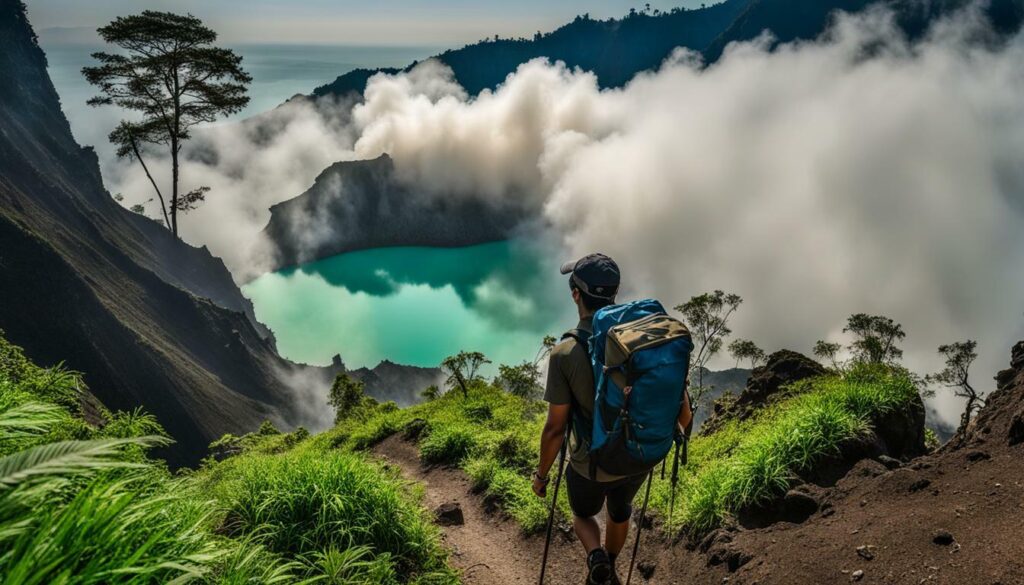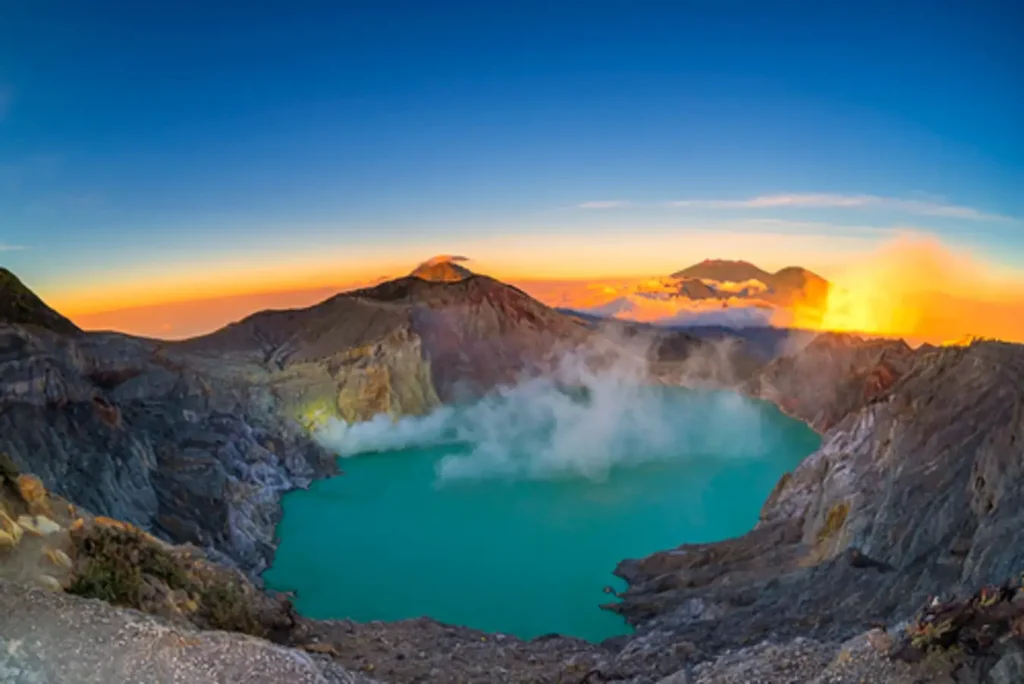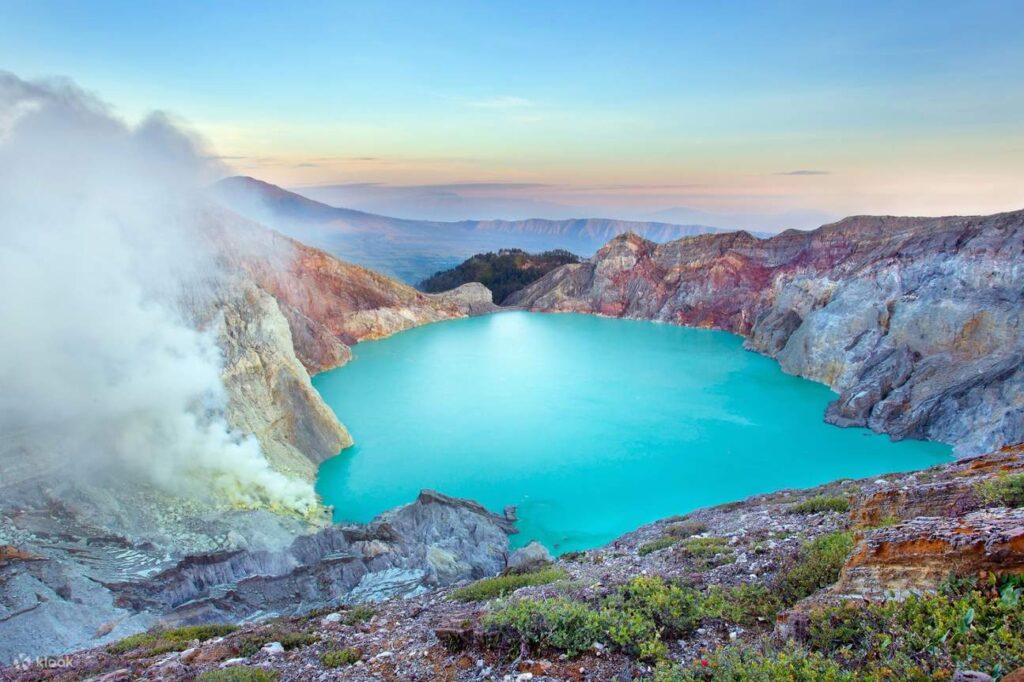Are you planning a trip to Indonesia and want to experience one of the most breathtaking natural wonders in the country? Look no further than Ijen Crater! This awe-inspiring destination is a must-visit for any nature lover or adventure seeker. However, planning a trip to Ijen Crater can seem daunting, as there are various logistics and considerations to keep in mind. That’s why we’ve put together this comprehensive guide to help you navigate your journey to Ijen Crater with ease.
Key Takeaways
- Visiting Ijen Crater in Indonesia is an unforgettable adventure for nature lovers and adventurers alike.
- A well-planned trip to Ijen Crater requires thorough knowledge of transportation options, timing, and hiking considerations.
- This guide will provide travelers with step-by-step instructions and essential tips for making the most of their trip to Ijen Crater.
Getting to Ijen Crater
The first step in planning your trip to Ijen Crater is figuring out how to reach the destination. The journey to Ijen Crater involves a combination of transportation modes and a hike. There are a few options to consider, depending on your budget and preferences.
Hiking to Ijen Crater
The hike to Ijen Crater takes around 1.5 to 2 hours and is considered moderately difficult. The ascent includes a steep incline, so it’s crucial to wear comfortable and sturdy walking shoes. The hike is not recommended for young children, and travelers with pre-existing medical conditions should consult a doctor before embarking on the journey.
Transportation to Ijen Crater
There are several transportation options for getting to Ijen Crater. The most popular ones include:
| Transportation Mode | Details |
|---|---|
| Private Car | A private car is the most convenient mode of transportation and can be arranged through local tour operators. The cost varies depending on the distance to be covered and the type of vehicle used. |
| Public Transport | Public buses and minibusses are available from Banyuwangi City to the Paltuding base camp, which is the starting point of the hike. The journey takes around 1.5 to 2 hours, and the fare is inexpensive. |
| Motorbike | Renting a motorbike is a popular choice for budget travelers. The journey from Banyuwangi City takes around 1.5 hours, and the rental cost is affordable. |
It’s important to note that the road leading to Ijen Crater is steep and winding, and it’s recommended to hire a skilled driver or rent a vehicle with a driver.
Once you’ve reached the base camp, you can start your ascent to Ijen Crater. Hiring a local guide is highly recommended, as they have extensive knowledge of the area and can ensure your safety throughout the hike.
Best Time to Visit Ijen Crater
Choosing the best time to visit Ijen Crater is crucial to fully enjoy its majestic beauty and avoid unwanted crowds or unfavorable weather conditions. Here are some factors to consider when planning your trip:
- Weather: The best time to visit Ijen Crater is during the dry season, which lasts from May to September. During this time, the weather is pleasant, and the skies are clear, offering perfect conditions for hiking and sightseeing. However, it’s essential to keep in mind that temperatures can drop significantly at night, so make sure to bring warm clothing.
- Crowds: If you prefer to avoid crowds, it’s best to visit Ijen Crater during the low season, which runs from October to April. During these months, visitor numbers are significantly lower, and you’ll have a better chance of experiencing the natural wonder without the crowds.
- Volcanic Activity: The Ijen Volcano is an active volcano, and its activity can affect visitor safety and accessibility to certain areas of the crater. It’s essential to check for updates on volcanic activity before and during your visit, and follow any safety precautions advised by local authorities.
Overall, the best time to visit Ijen Crater is during the dry season, from May to September, when the weather is ideal for hiking and sightseeing. However, if you prefer to avoid crowds, visiting during the low season, from October to April, can offer a more peaceful experience. Keep an eye on the volcanic activity, and plan accordingly to ensure a safe and enjoyable trip.
Exploring Ijen Crater
Once you’ve arrived at Ijen Crater, it’s time to explore all that this natural wonder has to offer. Whether you decide to go on a guided tour or explore on your own, there are several key aspects of the crater that you won’t want to miss.
Ijen Crater Tour
If you’re looking for a more structured and informative way to experience Ijen Crater, a guided tour may be the way to go. These tours typically include transportation to and from the crater, as well as a knowledgeable guide who can provide insights about the geography, geology, and history of the area.
While tours can be more expensive than exploring on your own, they can also be safer and more informative. Be sure to research different tour options and choose one that fits your budget and interests.
Entrance Fee
To enter Ijen Crater, you’ll need to pay an entrance fee. The cost varies depending on whether you’re a foreigner or Indonesian citizen, as well as whether you’re visiting during peak or off-peak season.
As of 2021, the entrance fee for foreign visitors during peak season is IDR 500,000 (approximately $35 USD), while the fee for Indonesian citizens is IDR 5,000 (approximately $0.35 USD). During off-peak season, the fees are slightly lower.
Ijen Crater Volcano
Ijen Crater is a volcano located in the eastern part of Java island, Indonesia. It’s known for its stunning turquoise-colored acidic lake, which is the largest acidic lake in the world. Additionally, the volcano emits sulfurous gases that ignite upon contact with air, creating the mesmerizing blue fire phenomenon that has become a highlight of any visit to Ijen Crater.
Be sure to take precautions when exploring the area around the volcano, as the gases can be toxic if inhaled in large quantities. Wear a face mask or respirator if necessary, and be mindful of the wind direction to avoid inhaling the gases.
Ijen Crater Blue Fire
The blue fire phenomenon at Ijen Crater is a rare and beautiful sight that attracts visitors from all over the world. The blue flames are created by the combustion of sulfuric gases that emerge from cracks in the volcano’s surface. To witness this stunning display, it’s best to visit the crater during the early hours of the morning, when the flames are most visible.
Remember to bring a camera and capture this unique experience in photos or video. However, be sure to turn off your flashlight when taking pictures to avoid overexposure.
Witnessing the Ijen Crater Sunrise Hike
One of the most awe-inspiring experiences you can have at Ijen Crater is witnessing the sunrise from its peak.
The hike to the top of Ijen Crater takes approximately two hours, so it’s recommended to start your hike in the early morning hours. We suggest starting your hike around 1 or 2 am to reach the top of the crater before sunrise.
It’s essential to bring appropriate hiking gear, including sturdy shoes, a headlamp or flashlight, and warm clothing. The temperature can drop significantly at night, so it’s crucial to dress in layers and bring a windbreaker jacket.
The trail to the top of Ijen Crater can be steep and challenging, so it’s essential to pace yourself and take breaks when necessary. It’s also recommended to hire a local guide to help navigate the trail and ensure your safety.
As you reach the top of Ijen Crater, you’ll witness the mesmerizing blue fire phenomenon, a natural wonder that occurs due to the sulfuric gas igniting on contact with air. It’s a truly remarkable sight that should be experienced at least once in a lifetime.
After marveling at the blue fire, find a spot to witness the sunrise over Ijen Crater. It’s a peaceful and awe-inspiring moment that will stay with you forever.
Remember to pack out any trash you bring with you and leave no trace of your visit, helping to preserve the natural beauty of Ijen Crater for future generations.
“Witnessing the sunrise from Ijen Crater is a truly magical experience that shouldn’t be missed.”
Conclusion
Exploring Ijen Crater is an unparalleled adventure that offers awe-inspiring natural beauty and unique volcanic phenomena. By following this comprehensive guide, you’ll be well-prepared for your journey to this breathtaking destination, whether you’re embarking on a sunrise hike or witnessing the mesmerizing blue fire.
We’ve covered all the key aspects of planning your trip, including transportation options, timing considerations, and essential safety precautions, and we’ve offered insights into the best ways to explore the crater and capture its beauty.
Prepare for an Unforgettable Journey
As you embark on your adventure to Ijen Crater, be sure to keep in mind the importance of respecting the environment and following local regulations to preserve this natural wonder for future generations.
With its stunning vistas, unique geological features, and unparalleled natural beauty, Ijen Crater is a destination that you’ll never forget. Prepare for an unforgettable journey and create memories that will last a lifetime.
FAQ
How do I get to Ijen Crater?
To reach Ijen Crater, you can take a flight to Surabaya or Bali and then hire a private car or join a tour to drive to the starting point of the hike.
What is the best time to visit Ijen Crater?
The best time to visit Ijen Crater is during the dry season, which is from May to September. This period offers clearer skies and better visibility for enjoying the stunning views.
Can I explore Ijen Crater without a guide?
While it is possible to explore Ijen Crater without a guide, it is highly recommended to hire a local guide. They have extensive knowledge about the area, can ensure your safety, and provide interesting insights during the hike.
How much is the entrance fee for Ijen Crater?
The entrance fee for Ijen Crater is IDR 100,000 (approximately $7) for foreign tourists. This fee goes towards the preservation and maintenance of the area.
Can I see the blue fire at Ijen Crater?
Yes, you can witness the mesmerizing blue fire phenomenon at Ijen Crater. It occurs due to the combustion of sulfuric gases and is best observed during the early hours of the morning.
What should I bring for the Ijen Crater sunrise hike?
It is essential to bring sturdy hiking shoes, warm clothing, a headlamp or flashlight, a gas mask or scarf to protect from sulfur fumes, and sufficient drinking water. Don’t forget to bring your camera to capture the breathtaking sunrise!





